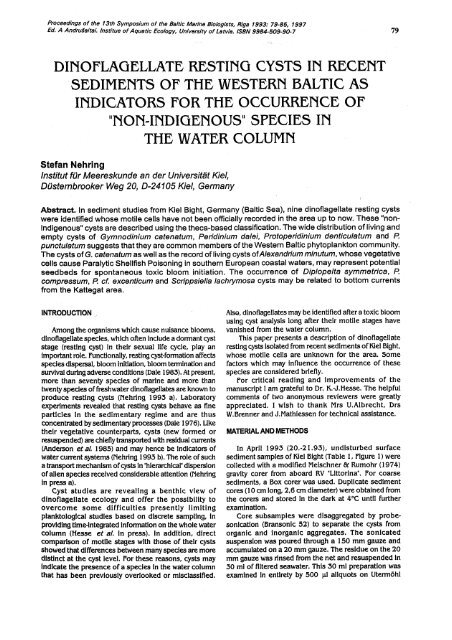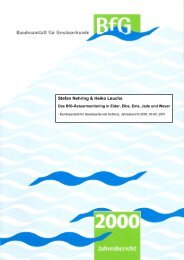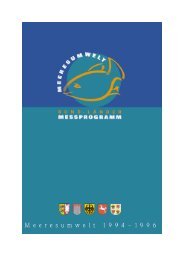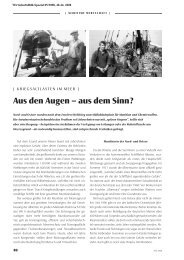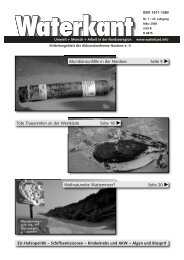Dinoflagellate resting cysts in recent sediments of the Western Baltic ...
Dinoflagellate resting cysts in recent sediments of the Western Baltic ...
Dinoflagellate resting cysts in recent sediments of the Western Baltic ...
You also want an ePaper? Increase the reach of your titles
YUMPU automatically turns print PDFs into web optimized ePapers that Google loves.
Proceed<strong>in</strong>gs <strong>of</strong> <strong>the</strong> 13th Symposium <strong>of</strong> <strong>the</strong> Saldo Mar<strong>in</strong>e Biologists, Riga 1993: 79-85, 1997<br />
Ed. A AndrugaitaL Institue <strong>of</strong> Aquatic Ecology, University <strong>of</strong> Latvia. ISBN 9984-509-90-7 79<br />
DINOFLAGELLATE RESTING CYSTS IN RECENT<br />
SEDIMENTS OF TIDE WESTERN BALTIC AS<br />
INDICATORS FOR TUE OCCURRENCE OF<br />
"NON-INDIGENOUS" SPECIES IN<br />
TUE WATER COLUMN<br />
Stefan Nehr<strong>in</strong>g<br />
Institut für Meereskunde an der Universität Kiel,<br />
Düstembrooker Weg 20, D-24105 Kiel, Germany<br />
Abstract. In sediment studies from Kiel Bight, Germany (<strong>Baltic</strong> Sea), n<strong>in</strong>e d<strong>in</strong><strong>of</strong>lagellate <strong>rest<strong>in</strong>g</strong> <strong>cysts</strong><br />
were identified whose motile cells have not been <strong>of</strong>ficially recorded <strong>in</strong> <strong>the</strong> area up to now. These "non<strong>in</strong>digenous"<br />
<strong>cysts</strong> are described us<strong>in</strong>g <strong>the</strong> <strong>the</strong>ca-based ciassification. The wide distribution <strong>of</strong> liv<strong>in</strong>g and<br />
empty <strong>cysts</strong> <strong>of</strong> Gymnod<strong>in</strong>ium catenatum, Perid<strong>in</strong>ium dalei, Protoperid<strong>in</strong>ium denticulatum and P.<br />
punctulatum suggests that <strong>the</strong>y are common members <strong>of</strong> <strong>the</strong> <strong>Western</strong> <strong>Baltic</strong> phytoplankton community.<br />
The <strong>cysts</strong> <strong>of</strong> G. catenatum as well as <strong>the</strong> record <strong>of</strong> liv<strong>in</strong>g <strong>cysts</strong> <strong>of</strong>Alexandrium m<strong>in</strong>utum, whose vegetative<br />
cells cause Paralytic Shellfish Poison<strong>in</strong>g <strong>in</strong> sou<strong>the</strong>rn European coastal waters, may represent potential<br />
seedbeds for spontaneous toxic bloom <strong>in</strong>itiation. The occurrence <strong>of</strong> Diplopelta symmetrica, P.<br />
compressum, P cf. excenticum and Scrippsiella lachtymosa <strong>cysts</strong> may be related to bottom currents<br />
from <strong>the</strong> Kattegat area.<br />
INTRODUCTION<br />
Among <strong>the</strong> organisms which cause nuisance blooms,<br />
d<strong>in</strong><strong>of</strong>lagellate species, which <strong>of</strong>ten <strong>in</strong>clude a dormant cyst<br />
stage (<strong>rest<strong>in</strong>g</strong> cyst) <strong>in</strong> <strong>the</strong>ir sexual life cycle, play an<br />
important role. Functionally, <strong>rest<strong>in</strong>g</strong> cyst-formation affects<br />
species dispersal, bloom <strong>in</strong>itiation, bloom term<strong>in</strong>ation and<br />
survival dur<strong>in</strong>g adverse conditions (Dale 1983). At present,<br />
more than seventy species <strong>of</strong> mar<strong>in</strong>e and more than<br />
twenty species <strong>of</strong> freshwater d<strong>in</strong><strong>of</strong>lagellates are known to<br />
produce <strong>rest<strong>in</strong>g</strong> <strong>cysts</strong> (Nehr<strong>in</strong>g 1993 a). Laboratory<br />
experiments revealed that <strong>rest<strong>in</strong>g</strong> <strong>cysts</strong> behave as f<strong>in</strong>e<br />
particles <strong>in</strong> <strong>the</strong> sedimentary regime and are thus<br />
concentrated by sedimentary processes (Dale 1976). Like<br />
<strong>the</strong>ir vegetative counterparts, <strong>cysts</strong> (new formed or<br />
resuspended) are chiefly transported with residual currents<br />
(Anderson et al. 1985) and may hence be <strong>in</strong>dicators <strong>of</strong><br />
water current systems (Nehr<strong>in</strong>g 1993 b). The role <strong>of</strong> such<br />
a Iransport mechanism <strong>of</strong> <strong>cysts</strong> <strong>in</strong> "hierarchicar dispersion<br />
<strong>of</strong> allen species received considerable attention (Nehr<strong>in</strong>g<br />
In press a).<br />
Cyst studies are reveal<strong>in</strong>g a benthic view <strong>of</strong><br />
d<strong>in</strong><strong>of</strong>lagellate ecology and <strong>of</strong>fer <strong>the</strong> possibility to<br />
overcome some difficulties presently limit<strong>in</strong>g<br />
planktological studies based on discrete sampl<strong>in</strong>g, <strong>in</strong><br />
provid<strong>in</strong>g time-Integrated <strong>in</strong>formation on <strong>the</strong> whole water<br />
column (liesse et a/. <strong>in</strong> press). <strong>in</strong> addition, direct<br />
comparison <strong>of</strong> motile stages with those <strong>of</strong> <strong>the</strong>ir <strong>cysts</strong><br />
showed that differences between many species are more<br />
dist<strong>in</strong>ct at <strong>the</strong> cyst level. For <strong>the</strong>se reasons, <strong>cysts</strong> may<br />
<strong>in</strong>dicate <strong>the</strong> presence <strong>of</strong> a species In <strong>the</strong> water column<br />
that has been previously overlooked or misclassified.<br />
Also, d<strong>in</strong><strong>of</strong>lagellates may be identified after a toxic bloom<br />
us<strong>in</strong>g cyst analysis long after <strong>the</strong>ir motile stages have<br />
vanished from <strong>the</strong> water column.<br />
This paper presents a description <strong>of</strong> d<strong>in</strong><strong>of</strong>lagellate<br />
<strong>rest<strong>in</strong>g</strong> <strong>cysts</strong> isoiated from <strong>recent</strong> <strong>sediments</strong> <strong>of</strong> Kiel Bight,<br />
whose motile cells are unknown for <strong>the</strong> area. Some<br />
factors which may <strong>in</strong>fluence <strong>the</strong> occurrence <strong>of</strong> <strong>the</strong>se<br />
species are considered briefly.<br />
For critical read<strong>in</strong>g and improvements <strong>of</strong> <strong>the</strong><br />
manuscript I am grateful to Dr. K.-J.liesse. The helpful<br />
comments <strong>of</strong> two anonymous reviewers were greatly<br />
appreciated. I wish to thank Mrs U.Albrecht, Drs<br />
W.Brenner and J.Mathiessen for technical assistance.<br />
MATERIAL AND METHODS<br />
In April 1993 (20.-21.93), undisturbed surface<br />
sediment samples <strong>of</strong> Kiel Bight (Table 1, Figure 1) were<br />
collected with a modified Meischner 5t Rumohr (1974)<br />
gravity corer from aboard RV "Littor<strong>in</strong>an. For coarse<br />
<strong>sediments</strong>, a Box corer was used. Duplicate sediment<br />
cores (10 cm long, 2,6 cm diameter) were obta<strong>in</strong>ed from<br />
<strong>the</strong> corers and stored <strong>in</strong> <strong>the</strong> dark at 4°C untll fur<strong>the</strong>r<br />
exam<strong>in</strong>ation.<br />
Core subsamples were disaggregated by probesonication<br />
(Bransonic 52) to separate <strong>the</strong> <strong>cysts</strong> from<br />
organic and <strong>in</strong>organic aggregates. The sonlcated<br />
suspension was poured through a 150 mm gauze and<br />
accumuiated on a 20 mm gauze. The residue on <strong>the</strong> 20<br />
mm gauze was r<strong>in</strong>sed from <strong>the</strong> net and resuspended <strong>in</strong><br />
30 ml <strong>of</strong> flltered seawater. This 30 ml preparation was<br />
examlned <strong>in</strong> entirety by 500 III aliquots on Utermöhl
80 Proceed<strong>in</strong>gs <strong>of</strong> <strong>the</strong> 13th Symposium <strong>of</strong> <strong>the</strong> <strong>Baltic</strong> Mar<strong>in</strong>e Biologists<br />
Table I. Position, water depth and sediment<br />
characteristics <strong>of</strong> Kiel Bight stations<br />
Station Name Coord<strong>in</strong>ates Water<br />
depth<br />
Sampl<strong>in</strong>g<br />
date<br />
Sediment<br />
type<br />
L1 Tonne 54°21,6011 13 m 21.04.93 mud<br />
Kiel 1 10°09,80'E<br />
L2 Klever- 54°27,50'N 20 m 21.04.93 mud<br />
berg 10°14,70'E<br />
L3 Kieler 54°29,20'N 19 m 21.04.93 mud<br />
Tief 10°19,40'E<br />
L4 Qabels- 54°31,90'N 11 m 21.04.93 sand<br />
flach 10°21,00'E<br />
L5 Boknis 54°32,10'N 24 m 21.04.93 muddy<br />
Eck 10°02,50'E sand<br />
L6 Dorsch- 54°37,25'N 21 m 20.04.93 mud<br />
mulde 10°18,60'E<br />
L7 Kieler 54°36,09'N 18 m 20.04.93 sandy<br />
Bucht 10°26,88'E mud<br />
L8 Süder- 54°32,45'N 22 m 20.04.93 mud<br />
fahrt 10°44,39'E<br />
L9 Flügge- 54°29,10'N 1 I m 20.04.93 mud<br />
sand 10°55,00'E<br />
slides us<strong>in</strong>g a Zeiss Axiovert <strong>in</strong>verted microscope. •<br />
For reference, <strong>in</strong>dividual <strong>cysts</strong> were picked out from<br />
Utermöhl slides and placed on microscopic slides with<br />
glycer<strong>in</strong>ejelly as <strong>the</strong> mount<strong>in</strong>g medium <strong>in</strong> a seal <strong>of</strong> wax.<br />
Some <strong>in</strong>dividual <strong>cysts</strong> were used for germ<strong>in</strong>ation<br />
experiments In order to identify species by <strong>the</strong>ir motile<br />
<strong>the</strong>cate stage. These <strong>cysts</strong> were isolated microscopically<br />
us<strong>in</strong>g a micropipette and washed twice <strong>in</strong> filtered<br />
seawater. The <strong>cysts</strong> were placed <strong>in</strong> small sterile<br />
<strong>in</strong>cubation chambers (Corn<strong>in</strong>g Cell Wells) conta<strong>in</strong><strong>in</strong>g<br />
filtered seawater <strong>of</strong> <strong>the</strong> sample location (Sal<strong>in</strong>ity 15.6 %o)<br />
or medium f/2 (Guillard, Ry<strong>the</strong>r 1962) and <strong>in</strong>cubated<br />
for a period <strong>of</strong> up to 14 days under natural light<br />
conditions at room temperature (--18°C).<br />
RESULTS<br />
The comprehensive cyst survey <strong>in</strong> Kiel Bight reveals<br />
that liv<strong>in</strong>g and empty <strong>cysts</strong> are widespread throughout<br />
<strong>the</strong> <strong>in</strong>vestigated stations. Altoge<strong>the</strong>r 25 cyst types were<br />
identified to species level (see Nehr<strong>in</strong>g <strong>in</strong> press b)<br />
whereby <strong>the</strong> motile cells <strong>of</strong> 9 species have not been<br />
<strong>of</strong>ficially recorded <strong>in</strong> <strong>the</strong> area so far.<br />
Many d<strong>in</strong><strong>of</strong>lagellate <strong>cysts</strong> have dual nomenclature,<br />
i.e. that <strong>the</strong> <strong>of</strong> cyst (palynological) and that <strong>of</strong> <strong>the</strong><br />
vegetative stage (biological). In this paper, <strong>cysts</strong> <strong>of</strong> "non<strong>in</strong>digenous"<br />
species will be described us<strong>in</strong>g biological<br />
nomenciature, although <strong>the</strong> palynological name is<br />
<strong>in</strong>cluded for reference If avallable.<br />
Alexandrium m<strong>in</strong>utum lialim<br />
Feure 2A, 5<br />
Erard-Le Denn et al. (1993), p. 110, fig. 2<br />
Cysts are circular <strong>in</strong> apical view (21-25 <strong>in</strong><br />
diameter) and reniform <strong>in</strong> lateral view (22 x 28 i_tm).<br />
The clear cyst wall is lightly covered with =eilage. A<br />
prom<strong>in</strong>ent orange-red accumulation body is present.<br />
Remarks: The cyst <strong>of</strong> A. mlnutum differs from <strong>the</strong><br />
<strong>cysts</strong> <strong>of</strong> o<strong>the</strong>r Alexandrium species <strong>in</strong> its shape (Dolch<br />
et al. 1991). At present this cyst type is known <strong>in</strong> Europe<br />
only from <strong>recent</strong> mar<strong>in</strong>e <strong>sediments</strong> <strong>of</strong> nor<strong>the</strong>rn France<br />
(Erard-le Denn et al. 1 993). In <strong>the</strong> present study,<br />
germ<strong>in</strong>ation experiments were not successful.<br />
Occurrence: Liv<strong>in</strong>g <strong>cysts</strong> (L5)<br />
Diplopelta symmetrica Pavillard<br />
FIgure 2C<br />
Dale et al. (1993), p.131, fig.5-8, 16, 17<br />
Brown, spherical to ovoidal cyst (40-45 .tm <strong>in</strong><br />
diameter) with a thick wall which is densely covered by<br />
th<strong>in</strong> (hair-like) processes (1.4 .im long). The archeopyle<br />
is a slit (<strong>the</strong>ropylic type sensu Matsuoka 1985).<br />
Remarks: The unequivocal cyst <strong>of</strong> D. symmetrica was<br />
first described by Dale et al. (1993) from <strong>the</strong> Osl<strong>of</strong>jord<br />
and from a Italian Lagoon. In Kiel Bight <strong>sediments</strong>, only<br />
empty <strong>cysts</strong> were found.<br />
Ocanrence: Empty <strong>cysts</strong> (L8)<br />
Pigure I. Study area - <strong>the</strong> Kiel Bight (<strong>Baltic</strong> Sea) with<br />
location <strong>of</strong> stations <strong>in</strong>vestigated.<br />
GymnodInium catenatum Graham<br />
Feure 2D<br />
Bolch, liallegraeff (1990), p.186, figs.33a-c<br />
Brown, spherical cyst (30-35 .tm diameter) with<br />
globular contents. A prom<strong>in</strong>ent red accumulation body<br />
is preseht. The cyst surface is micro-reticulated and<br />
reflects <strong>the</strong> girdle, <strong>the</strong> sulcus and <strong>the</strong> apical groove <strong>of</strong><br />
<strong>the</strong> vegetative cell. The archeopyle is a long slit along<br />
<strong>the</strong> parac<strong>in</strong>gulum (chasmic type sensu Matsuoka 1985).<br />
Several empty <strong>cysts</strong> showed an additional step-like<br />
fracture on <strong>the</strong> slit.<br />
flemarks: This cyst type is known <strong>in</strong> Europe from<br />
<strong>recent</strong> mar<strong>in</strong>e <strong>sediments</strong> <strong>of</strong> <strong>the</strong> Iberian pen<strong>in</strong>sula and<br />
was <strong>recent</strong>ly reported for Nor<strong>the</strong>rn Europe waters from<br />
<strong>the</strong> North Sea and <strong>the</strong> Kattegat area (Ellegaard et<br />
1993, Nehr<strong>in</strong>g 1993 b). Cysts <strong>of</strong> <strong>the</strong> North Sea, Kattegat
Proceed<strong>in</strong>gs <strong>of</strong> <strong>the</strong> .13th Symposium <strong>of</strong> <strong>the</strong> <strong>Baltic</strong> Mar<strong>in</strong>e Biologists 81<br />
and Kiel Bight are slightly smaller (30-40 um vs. 37-<br />
60 om) than those described from o<strong>the</strong>r parts <strong>of</strong> <strong>the</strong><br />
world (see Nehr<strong>in</strong>g <strong>in</strong> press a). G. catenatum is known<br />
to form characteristic snake-like cha<strong>in</strong>s consist<strong>in</strong>g <strong>of</strong> up<br />
to 64 s<strong>in</strong>gle <strong>in</strong>dividuals (BEackburn et al. 1 989). All<br />
germ<strong>in</strong>ated specimens from Kiel Bight produced not<br />
more than two cell pairs.<br />
Occurrence: Liv<strong>in</strong>g <strong>cysts</strong> (L5, L6, 17, L8)<br />
Empty <strong>cysts</strong> (L3, L5, L6, L7, L8)<br />
for Gonyaulax polyedra and Protoceratium reticulatum<br />
and <strong>in</strong>terpreted as an impact <strong>of</strong> sal<strong>in</strong>ity on cyst<br />
morphology. Similar observations were made by Wall et<br />
al. (1973) <strong>in</strong> low sal<strong>in</strong>ity assembtages from late<br />
Quaternary <strong>sediments</strong> <strong>in</strong> <strong>the</strong> Black Sea. In present study,<br />
most <strong>cysts</strong> germ<strong>in</strong>ated.<br />
Occurrence:<br />
Liv<strong>in</strong>g <strong>cysts</strong> (L1, L2, L3 L4, L5, L6, L7, L8)<br />
Empty <strong>cysts</strong> (L1, L2, L3, L4, L5, L6, 17, L8)<br />
Perld<strong>in</strong>ium daleiandelicato & Loeblich) Balech<br />
Figure 2E<br />
Lewis (1991), p.95, 96, figs. 10-16<br />
Cysts are spherical or slightly subspherical (20-28<br />
um diarneter excl. sp<strong>in</strong>es; sp<strong>in</strong>es length 2.5 gm) and a<br />
red accumulation body is <strong>of</strong>ten visible. The cyst wall is<br />
clear and <strong>the</strong> archeopyle is a simple split. Norrnally,<br />
numerous sp<strong>in</strong>es are developed, but Kiel Bight specimen<br />
showed a clear tendency for progressive reduction <strong>of</strong><br />
process-length, compared with specimens from <strong>the</strong><br />
North Sea (Nehr<strong>in</strong>g <strong>in</strong> press a).<br />
Remarks: Reduction <strong>of</strong> process-length <strong>in</strong> <strong>Baltic</strong> Sea<br />
specimens was observed by Nehr<strong>in</strong>g (<strong>in</strong> press b) also<br />
Protoperid<strong>in</strong>ium compressum ( ALD) Balech<br />
Figure 2F<br />
(Pal<strong>in</strong>ological taxon: Stelladlnium stellatum (Wall) Reid)<br />
Reid (1977), p.44.3, p1.2 figs. 19, 20<br />
Dorso-ventrally compressed pale brown cyst (28-32<br />
urn wide, horns excluded) with smooth wall and unique<br />
stellate morphology. The cyst carries 5 homs, one apical,<br />
two antapical and two lateral horns, which are long (up<br />
to 22 pm), solid and needte-shaped. The archeopyle is<br />
on <strong>the</strong> anterior dorsal surface and formecl by loss <strong>of</strong> <strong>the</strong><br />
2a <strong>in</strong>tercalary paraplate.<br />
Remarks: The unequivocal cyst <strong>of</strong> P.compressurn<br />
differs from 5. reidii <strong>cysts</strong> (Bradford 1975) <strong>in</strong> its smaller<br />
G<br />
Figure 2. Rest<strong>in</strong>g <strong>cysts</strong> <strong>of</strong> d<strong>in</strong>otlagellates isolated from <strong>recent</strong> <strong>Baltic</strong> Sea <strong>sediments</strong>, which do not have vegetative<br />
cells <strong>in</strong>digenous from this region. A - 13: Alexandrium miauturn, A: Liv<strong>in</strong>g cyst with red accumulation body<br />
(arrow), apical view; 13: liv<strong>in</strong>g cyst, lateral view. Cyst <strong>of</strong> Diplopelta syrnmetrica with hair-like processes. D:<br />
Gymnod<strong>in</strong>ium catenaturn, cyst split open (chasmic type <strong>of</strong> archeopyle) roughly around one edge <strong>of</strong> parac<strong>in</strong>gul um.<br />
E: Cyst <strong>of</strong> Perld<strong>in</strong>ium dalei with red accumulation body (arrow). Empty cyst <strong>of</strong> Frotoperld<strong>in</strong>ium compressum.<br />
G: Empty cyst <strong>of</strong> Frotopericl<strong>in</strong>ium denticulatum show<strong>in</strong>g hexagonal archeopyle. 11: Apical view <strong>of</strong> ernpty cyst <strong>of</strong><br />
Frotoperid<strong>in</strong>ium cf. excentricum. Scale bar: 18 }..tm <strong>in</strong> (A-E), 20 }..tm <strong>in</strong> (F-I1).
82 Proceed<strong>in</strong>gs <strong>of</strong> <strong>the</strong> 13th Symposium <strong>of</strong> <strong>the</strong> <strong>Baltic</strong> Mar<strong>in</strong>e Biologists<br />
size, solid processes and smaller archeopyle. Only empty<br />
<strong>cysts</strong> were found.<br />
accurrence: Empty <strong>cysts</strong> (L8)<br />
Protoperid<strong>in</strong>ium denticulatum ( Gran & Braarud) Balech<br />
Feure 20<br />
Wall & Date (1968), p.277, Pl. 3 fig. 30<br />
Brown spherical cyst (40-45 prn diameter) with a<br />
smooth wall. The archeopyle is hexagonal, laterally<br />
eiongated (shaped by two lang sides which are slightly<br />
curved and Tour <strong>in</strong>termediate sides) and formed by <strong>the</strong><br />
loss <strong>of</strong> <strong>the</strong> 2a <strong>in</strong>tercalary paraplate.<br />
Remarks: At present, <strong>the</strong> cyst and archeopyle<br />
morphology <strong>of</strong> round brown <strong>cysts</strong> does not reveal dist<strong>in</strong>ct<br />
criteria for species determ<strong>in</strong>ation. Confusion with several<br />
o<strong>the</strong>r species form<strong>in</strong>g very similar <strong>cysts</strong> is possible (see<br />
below, P. punctulatum). In <strong>the</strong> present study, one cyst<br />
gerrn<strong>in</strong>atecl and was identified as P. denticulatum.<br />
Occurren ce:<br />
Liv<strong>in</strong>g <strong>cysts</strong> (L I , L2, L3, L4, L5, L6, L7, L8, L9)<br />
Empty <strong>cysts</strong> (L3, L4, L5,L6, L7)<br />
Protopend<strong>in</strong>iurn cf. excentricum (Paulsen) Balech<br />
figure 211<br />
Lewis et al.(l 984), p.26, 28, fig. 2h<br />
Brown and smooth-walled cyst which is slightly<br />
dorsoventraly flattened (48 um x 54 um). An <strong>in</strong>dented<br />
parasulcus is <strong>of</strong>ten visible. Cyst is sometimes enclosed<br />
by <strong>the</strong> parental <strong>the</strong>ca.<br />
Re marks: Ellegaard et 81. (<strong>in</strong> press) found a similar<br />
cyst type <strong>in</strong> <strong>recent</strong> Kattegat sedirnents and identified it<br />
by germ<strong>in</strong>ation experiments as P. excentricum. No<br />
specimen from Kiel Bight germ<strong>in</strong>ated.<br />
Occurrence; Liv<strong>in</strong>g <strong>cysts</strong> (L2, L7, L8)<br />
Empty <strong>cysts</strong> (L5, L6, L7, L8)<br />
Protoperichkiltr<strong>in</strong> punctulaturn (Paulsen) Belech<br />
Feure 5A<br />
Brown spherical cyst (52-62 urn <strong>in</strong> diameter) with a<br />
smooth wall. The archeopyle is hexagonal, laterally<br />
elongated (shaped by two long sides, one <strong>of</strong> which is<br />
curved, and two relatively long and two short<br />
<strong>in</strong>tennediate sides) and formed by <strong>the</strong> loss <strong>of</strong> <strong>the</strong> 2a<br />
<strong>in</strong>tercalary paraplate.<br />
figure 3. Rest<strong>in</strong>g <strong>cysts</strong> <strong>of</strong> d<strong>in</strong><strong>of</strong>lagellates isolated from <strong>recent</strong> <strong>Baltic</strong> Sea <strong>sediments</strong>, which do not have vegetative<br />
cells <strong>in</strong>digenous from this region. A - D: Protoperid<strong>in</strong>ium punctulatum, A: Ernpty cyst show<strong>in</strong>g hexagonal archeopyle;<br />
B: excysted germl<strong>in</strong>g cell with sp<strong>in</strong>y surface, optical cross section; C: Details <strong>of</strong> plate tubulation <strong>in</strong>clud<strong>in</strong>g <strong>the</strong><br />
shape <strong>of</strong> <strong>the</strong> first apical plate (I'); D: Dorsal view show<strong>in</strong>g <strong>the</strong> sulcal area and c<strong>in</strong>gulum. E-F: Scripsiella lac - hrymosa,<br />
E: Empty cyst, optical cross section; Cyst show<strong>in</strong>g calcareous ornament an surface. Scale bar: 18 um <strong>in</strong> (A-r).
Proceed<strong>in</strong>gs <strong>of</strong> <strong>the</strong> 13th Symposium <strong>of</strong> <strong>the</strong> <strong>Baltic</strong> Mar<strong>in</strong>e Biologists 83<br />
Ifemarks: germ<strong>in</strong>ation <strong>of</strong> Kiel Bight specimens<br />
resulted <strong>in</strong> <strong>the</strong> unequivocal vegetative cells <strong>of</strong> P.<br />
punctulatum (Figure 3B-D). There were slight variations<br />
<strong>in</strong> <strong>the</strong> archeopyle <strong>of</strong> this species. Wall & Dale (1968)<br />
described <strong>the</strong> archeopyle <strong>of</strong> P. punctulatum as<br />
asymmetrical, specimens from Kiel Bight showed an<br />
symmetrical archeopyle. Round brown <strong>cysts</strong> have been<br />
a challenge to taxonomists or a long time. More critical<br />
work is requlred to elucidate this situation. After<br />
germ<strong>in</strong>ation <strong>the</strong>re is still confusion, as <strong>the</strong> <strong>the</strong>cate stages<br />
<strong>of</strong> P. avellana, P. denticulatum, P.pundtuIatum and P.<br />
thorlanum have very similar 2a plates (and <strong>cysts</strong> have<br />
hence similar archeopyles). Eventually cyst size may be<br />
a dist<strong>in</strong>ctive feature. however, this has not been<br />
confirmed.<br />
Occurrencez<br />
Liv<strong>in</strong>g <strong>cysts</strong> (L1, L2, L3, L4, L5, L6, L7, L8, L9)<br />
Empty <strong>cysts</strong> (L1, L2, L3, 1.4, L5, L6, L7, L8, L9)<br />
Scrlppslella lachryrnosa Lewis<br />
Feure 3E,<br />
Lewis (1991), p.98, 99, fig. 30-32<br />
Elongate oval <strong>cysts</strong> covered with th<strong>in</strong>, flattened<br />
calcareous plates which are jo<strong>in</strong>tly <strong>in</strong>dented. The cyst is<br />
37 to 47 j.tm long and 19 to 35 gm wide. In liv<strong>in</strong>g <strong>cysts</strong>,<br />
a bright red accumulation body is visible (own<br />
observation on North Sea material). The archeopyle is a<br />
split towards one end <strong>of</strong> <strong>the</strong> cyst form<strong>in</strong>g a cap shaped<br />
operculum and <strong>in</strong>terpreted by Lewis (1991) as loss <strong>of</strong><br />
paraplates 2'-4' and 1-3a.<br />
fiemarks: The unequivocal cyst <strong>of</strong> 5. laclnymosa was<br />
first described by Lewis (1991) from Scottish Sea Lochs<br />
and a similar cyst type was reported by Blanco (1989,<br />
p.800, Figure 5) as 5. trocholdea, a largado from <strong>the</strong><br />
Galician coast. Nehr<strong>in</strong>g (<strong>in</strong> press c) and Nehr<strong>in</strong>g et al.<br />
(<strong>in</strong> press) showed that <strong>the</strong> cyst <strong>of</strong> 5. laclnymosa is a<br />
common member <strong>of</strong> <strong>the</strong> North Sea cyst flora. In Kiel<br />
Bight <strong>sediments</strong> only empty <strong>cysts</strong> were found.<br />
Occurrence: Empty <strong>cysts</strong> (L8)<br />
DISCUSSION<br />
Studies on <strong>rest<strong>in</strong>g</strong> <strong>cysts</strong> are important for <strong>the</strong><br />
understand<strong>in</strong>g <strong>of</strong> many aspects <strong>of</strong> d<strong>in</strong><strong>of</strong>lagellate ecology<br />
and blogeography (Dale 1983). Accumulations <strong>of</strong> <strong>cysts</strong><br />
have been observed <strong>in</strong> a variety <strong>of</strong> mar<strong>in</strong>e ecosystems,<br />
<strong>in</strong>clud<strong>in</strong>g <strong>of</strong>fshore trenches and depressions, fjords,<br />
estuaries and shallow coastal embayments (e.g. Baldw<strong>in</strong><br />
1987, Matsuoka 1987, Bolch & Hallegraeff 1990).<br />
However, only a few cyst studies were compared with°<br />
extensive plankton records from overly<strong>in</strong>g waters. For<br />
<strong>the</strong> area <strong>of</strong> <strong>the</strong> German Bight (North Sea), about 25 0 /0<br />
<strong>of</strong> <strong>the</strong> locally occurr<strong>in</strong>g d<strong>in</strong><strong>of</strong>lagellate species contribute<br />
<strong>cysts</strong> to bottom sentiments (Nehr<strong>in</strong>g 1994, <strong>in</strong> press c).<br />
However, Nehr<strong>in</strong>g (<strong>in</strong> press c) and Nehr<strong>in</strong>g etal. (<strong>in</strong> press)<br />
showed that <strong>the</strong> <strong>recent</strong> cyst flora <strong>in</strong> North Sea <strong>sediments</strong><br />
conta<strong>in</strong>ed several species whose motile forms had not<br />
been observed <strong>in</strong> <strong>the</strong> area up to now. In <strong>the</strong> case <strong>of</strong> <strong>the</strong><br />
present study, <strong>the</strong> wide distribution <strong>of</strong> liv<strong>in</strong>g empty <strong>cysts</strong><br />
<strong>of</strong> Gymnod<strong>in</strong>ium catenatum, Perld<strong>in</strong>ium daleI,<br />
Protopericl<strong>in</strong>ium denticu/atum and P. punctulaturn and<br />
<strong>the</strong> positive germ<strong>in</strong>ation experiments with natural<br />
seawater from Kiel Bight suggest that <strong>the</strong>se forms are<br />
common members <strong>of</strong> <strong>the</strong> <strong>Western</strong> <strong>Baltic</strong> phytoplankton<br />
community. In <strong>the</strong> area <strong>of</strong> Kiel Bight, altoge<strong>the</strong>r about<br />
15 % <strong>of</strong> <strong>the</strong> locally occurr<strong>in</strong>g d<strong>in</strong><strong>of</strong>lagellate species have<br />
developed <strong>rest<strong>in</strong>g</strong> cyst formation <strong>in</strong> <strong>the</strong>ir life cycle and<br />
used it actively (Nehr<strong>in</strong>g press b).<br />
In France, s<strong>in</strong>ce 1985, toxic algal blooms <strong>of</strong> <strong>the</strong> PSPproduc<strong>in</strong>g<br />
speciesAlexandrium m<strong>in</strong>utum have occurred<br />
along <strong>the</strong> Brittany coast with<strong>in</strong> small embayments or<br />
shallow estuaries (Nezan, Le Doux 1989). The cyst <strong>of</strong> A.<br />
m<strong>in</strong>utum from Kiel bight conforms with <strong>the</strong> description<br />
and figure given by Erard-Le Denn et a/. (1993) from <strong>the</strong><br />
Brittany coast. The described occurrence <strong>of</strong><br />
Gymnod<strong>in</strong>lum catenatum <strong>cysts</strong> <strong>in</strong> Kiel Bight <strong>sediments</strong><br />
is remarkable, because <strong>the</strong> present day distribution <strong>of</strong><br />
vegetative cells <strong>of</strong> PSP-produc<strong>in</strong>g G.catenatum <strong>in</strong><br />
European waters extends only to <strong>the</strong> Atlantic and<br />
Mediterranean coast <strong>of</strong> <strong>the</strong> Iberian pen<strong>in</strong>sula (Estrada<br />
et al. 1984, Bravo et a/. 1990) and is recorded from a<br />
Italian lagoon (Carrada etal. 1991). There are no reports<br />
<strong>of</strong> ei<strong>the</strong>r species <strong>in</strong> any <strong>of</strong> <strong>the</strong> numerous <strong>in</strong>vestigations<br />
<strong>of</strong> liv<strong>in</strong>g phytoplankton from nor<strong>the</strong>rn European waters<br />
(Elbrächter pers. comm.). However, s<strong>in</strong>ce March 1992,<br />
liv<strong>in</strong>g 0. catenatum <strong>cysts</strong> were found <strong>in</strong> <strong>in</strong>creas<strong>in</strong>g<br />
abundances <strong>in</strong> <strong>the</strong> German Bight (Nehr<strong>in</strong>g 1993 b,<br />
Nehr<strong>in</strong>g <strong>in</strong> press a, c), and were also recorded from<br />
<strong>recent</strong> <strong>sediments</strong> <strong>of</strong> <strong>the</strong> Danish coast border<strong>in</strong>g <strong>the</strong><br />
Kattegat (Ellegaard et al. 1993).<br />
The cyst <strong>of</strong> 0. catenatum from Kiel Bight conforms<br />
with <strong>the</strong> specimen isolated from German Bight <strong>sediments</strong><br />
and with <strong>the</strong> description given by Ellegaard et al. (1993)<br />
from <strong>the</strong> Kattegat area. Curiously, cha<strong>in</strong> form<strong>in</strong>g <strong>in</strong> <strong>the</strong><br />
vegetative stage does not exceed more than two cells<br />
<strong>in</strong> <strong>the</strong> North Sea, Kattegat and Kiel Bight specimens.<br />
Recentiy, Paulmier (1992) described s<strong>in</strong>gle cells and<br />
cha<strong>in</strong>s <strong>of</strong> two cells <strong>of</strong> a very similar and perhaps<br />
conspecific species (provisionally recorded as 0. cf.<br />
catenatum) at <strong>the</strong> channel coast <strong>of</strong> France <strong>in</strong> 1983 and<br />
1984. <strong>the</strong>se E<strong>in</strong>d<strong>in</strong>gs suggest that <strong>the</strong> toxic G. catenatum<br />
was transported as cyst or motile cell by currents along<br />
<strong>the</strong> Atlantic coast <strong>of</strong> Spa<strong>in</strong> and France.<br />
The <strong>in</strong>troduction <strong>of</strong> A. m<strong>in</strong>utum, as well as G.<br />
catenatum to German coastal waters may be related to<br />
<strong>in</strong>crease water <strong>in</strong>flux through <strong>the</strong> English Channel <strong>in</strong>to<br />
<strong>the</strong> North Sea (Becker, Dooley <strong>in</strong> press). The northward<br />
directed residual currents may have transported cells<br />
to <strong>the</strong> Skagerrak/Kattegat region. In January 1993, a<br />
massive salt water <strong>in</strong>flux from <strong>the</strong> Kattegat through <strong>the</strong><br />
Great Belt <strong>in</strong>to <strong>the</strong> <strong>Western</strong> <strong>Baltic</strong> occurred (Anonymous<br />
1993) and may have <strong>in</strong>fected this area with A. m<strong>in</strong>utum<br />
and 0. catenatum cells. However, it is not yet sure we<strong>the</strong>r<br />
<strong>the</strong> depicted scenario is true <strong>in</strong> <strong>the</strong> case <strong>of</strong> A. m<strong>in</strong>utum,<br />
because <strong>rest<strong>in</strong>g</strong> <strong>cysts</strong> <strong>of</strong> this species were not detected<br />
<strong>in</strong> <strong>sediments</strong> <strong>of</strong> <strong>the</strong> German Bight (Nehr<strong>in</strong>g <strong>in</strong> press c)<br />
and <strong>the</strong> Kattegat area (Ellegaard et al. <strong>in</strong> press). As<br />
po<strong>in</strong>ted out by Ner<strong>in</strong>g (<strong>in</strong> press d), lt is quite possible
84 Proceed<strong>in</strong>gs <strong>of</strong> <strong>the</strong> 13th Symposium <strong>of</strong> <strong>the</strong> <strong>Baltic</strong> Mar<strong>in</strong>e Biologists<br />
that vegetative cells <strong>of</strong> <strong>the</strong> potentially toxic A. m<strong>in</strong>utum<br />
have been overlooked <strong>in</strong> <strong>the</strong> plankton <strong>of</strong> <strong>the</strong> <strong>Western</strong><br />
<strong>Baltic</strong> because <strong>of</strong> <strong>the</strong>ir small, <strong>in</strong>conspicuous shape and<br />
scarce occurrence. The positive germ<strong>in</strong>ation<br />
experiments with G. catenatum <strong>in</strong> this study and by<br />
Ellagaard et al. (1993), which were conducted with<br />
natural sea water from <strong>the</strong> sample locations, show that<br />
also <strong>the</strong> occurrence <strong>of</strong> vegetative and potentially toxic<br />
0. catenatum, and possibly A.m<strong>in</strong>uturn, <strong>in</strong> <strong>Western</strong> <strong>Baltic</strong><br />
waters is very likely. Phytoplankton monitor<strong>in</strong>g programs<br />
must asses this problem.<br />
The cyst <strong>of</strong> Pere<strong>in</strong>turn da/elpossesses unequivocal<br />
morphological features, whereas <strong>the</strong> vegetative stage is<br />
ra<strong>the</strong>r difficult to recognise by light microscopy because<br />
<strong>of</strong> its small size confusion with <strong>the</strong> closely related<br />
orthoperid<strong>in</strong>oid species (e.g. Scrippsiella trochoidea,<br />
which is a common species <strong>in</strong> <strong>the</strong> <strong>Western</strong> <strong>Baltic</strong>). lt is<br />
suggested that due to <strong>the</strong>se taxonomical difficulties,<br />
vegetative cells <strong>of</strong> P. dalei were overlooked <strong>in</strong> <strong>the</strong> region<br />
up to now.<br />
Propere<strong>in</strong>ium denticulatum and P. punctulaturn,<br />
which are not known to occur as motile stages <strong>in</strong> <strong>the</strong><br />
plankton <strong>of</strong> Kiel Bight, are present <strong>in</strong> adjacent North<br />
sea waters. <strong>the</strong>se species are ra<strong>the</strong>r easy to identify even<br />
<strong>in</strong> preserved samples and it seems unlikely that <strong>the</strong>y<br />
might have escaped observation. Their wide distribution<br />
as liv<strong>in</strong>g and empty <strong>cysts</strong> <strong>in</strong> Kiel Bight <strong>sediments</strong> suggests<br />
that <strong>the</strong>se forms are ra<strong>the</strong>r common <strong>in</strong> <strong>the</strong> phytoplankton<br />
community <strong>of</strong> <strong>the</strong> region, at least for delimited periods.<br />
The ma<strong>in</strong> occurrence <strong>of</strong> <strong>cysts</strong> <strong>of</strong> Protopere<strong>in</strong>turn cl:<br />
excentricum <strong>in</strong> <strong>the</strong> deeper area <strong>of</strong> Kiel Bight may be a<br />
consequence <strong>of</strong> <strong>the</strong> reported satt water <strong>in</strong>fiux mentioned<br />
above, because both <strong>cysts</strong> and motile cells are common<br />
<strong>in</strong> <strong>the</strong> Kattegat area (Ellegaard et al. In press, Pankow<br />
1990). Likewise, an import <strong>of</strong> empty <strong>cysts</strong> <strong>of</strong> Diplopelta<br />
symmetdca, Pcompressum and Scrippsiella lachomosa<br />
is suggested, because <strong>the</strong> former cyst type is known<br />
from Osl<strong>of</strong>jord (Dale et al. 193) both o<strong>the</strong>r cyst types<br />
are known from <strong>recent</strong> North Sea <strong>sediments</strong> (Nehr<strong>in</strong>g <strong>in</strong><br />
press c) and P.compressum <strong>cysts</strong> from <strong>recent</strong> Kattegat<br />
<strong>sediments</strong> as well (Ellegaard et al. <strong>in</strong> press).<br />
Cyst surveys provide a relatively <strong>in</strong>expensive and easy<br />
way to obta<strong>in</strong> <strong>in</strong>formation about <strong>the</strong> occurrence <strong>of</strong> cystform<strong>in</strong>g<br />
species. The benefits are <strong>in</strong>creased if no<br />
historical phytoplankton data is avallable. Cyst studies<br />
<strong>of</strong>fer a potential tool for early warn<strong>in</strong>g <strong>of</strong> <strong>the</strong> presence<br />
<strong>of</strong> a toxic species and Future nuisance blooms <strong>in</strong> a given<br />
area (Ellegaard et.« 1993, Nehr<strong>in</strong>g 1993 b, Nehr<strong>in</strong>g <strong>in</strong><br />
press d), s<strong>in</strong>ce this <strong>in</strong>formation is not dependent on<br />
bloom periods. Recently, attention has been given to<br />
<strong>the</strong> possibility <strong>of</strong> d<strong>in</strong><strong>of</strong>lagellate spread by transport <strong>of</strong><br />
<strong>cysts</strong> via ships ballast water (Hallegraeff, Solch 1991).<br />
Cyst studies, such as <strong>the</strong> present, merely show a relation<br />
<strong>of</strong> cyst distribution with water mass characteristics and<br />
current systems. In this way, areas hi<strong>the</strong>rto free <strong>of</strong> algal<br />
problems may be <strong>in</strong>fected with harmful species. In this<br />
context lt is to be expected that chang<strong>in</strong>g water<br />
circulation as a result <strong>of</strong> cllmate change will br<strong>in</strong>g about<br />
some surpris<strong>in</strong>g effects.<br />
REFERENCES<br />
Anderson, D.M., Lively, J.J., Reardon, E.M., Price,<br />
C.A. (1985). S<strong>in</strong>k<strong>in</strong>g characteristics <strong>of</strong> d<strong>in</strong><strong>of</strong>lagellate<br />
<strong>cysts</strong>. Limnol. Oceanogr. 30: 1000-1009<br />
Anonymous (1993). Report an <strong>the</strong> conditions <strong>of</strong> <strong>the</strong><br />
coastal and <strong>of</strong>f shore waters <strong>of</strong> <strong>the</strong> <strong>Baltic</strong> Proper.<br />
Information Office for <strong>the</strong> <strong>Baltic</strong> Proper, Stockholm,<br />
Information 11/93<br />
Baidw<strong>in</strong>, R.P. (1987). <strong>D<strong>in</strong><strong>of</strong>lagellate</strong> <strong>rest<strong>in</strong>g</strong> <strong>cysts</strong><br />
isolated from <strong>sediments</strong> <strong>in</strong> Marlborough Sounds, New<br />
Zealand. N.Z.J. Mar.Freshw.Res. 21: 543.553<br />
Becker, G., Dooley, H.D. (<strong>in</strong> press). The 1989/91 high<br />
sal<strong>in</strong>ity anomaly <strong>in</strong> <strong>the</strong> North Sea and adjacent areas.<br />
Ocean Challenge<br />
Blackburn, S.I., Hallegraeff, G.M., Bolsh, C.J. (1989).<br />
Vegetative reproduction and sexual life cycle <strong>of</strong> <strong>the</strong> toxic<br />
d<strong>in</strong><strong>of</strong>iagellate Gymnodium catenatum from Tasmania,<br />
Australia. J.Phycol. 25: 577-590<br />
Bolch, C.J., Hallegraeff, G.M. (1990). D<strong>in</strong><strong>of</strong>iagellate<br />
<strong>cysts</strong> <strong>in</strong> <strong>recent</strong> mar<strong>in</strong>e <strong>sediments</strong> from Tasmania,<br />
Austral la. Bot.Mar. 33: 173-192<br />
Solch, C.J., Blackburn, S.I., Cannon J.A., Hallegraeff,<br />
G.M. (1991). The ret<strong>in</strong>g cyst <strong>of</strong> <strong>the</strong> red-tide d<strong>in</strong><strong>of</strong>lagellate<br />
Alexandrium m<strong>in</strong>utum (D<strong>in</strong>ophyceae). Phycologia 30:<br />
215-219<br />
Bradfrod, M.R. (1975). New d<strong>in</strong><strong>of</strong>lagellate cyst genera<br />
from <strong>the</strong> <strong>recent</strong> <strong>sediments</strong> <strong>of</strong> <strong>the</strong> Persian Gulf. Can.J.Bot.<br />
53: 3064-3075<br />
Bravo, I., Reguera, B., Mart<strong>in</strong>ez, A., Fraga, S. (1990).<br />
First report <strong>of</strong> Gymnod<strong>in</strong>ium catenatum Graham on <strong>the</strong><br />
Spanish Mediterranean coast. In: Granell, E.,<br />
Sundstrom,B., Edler, L. Anderson, D.M. (eds.). Toxic<br />
Mar<strong>in</strong>e Phytoplankton. Elsevier, New York, p. 449-452<br />
Carrada, G.C., Casotti, R., Modigh, M., Saggiomo, V.<br />
(1991). Presence <strong>of</strong> Gymnod<strong>in</strong>ium catenatum<br />
(D<strong>in</strong>ophyceae) <strong>in</strong> coastal Mediterranean lagoon.<br />
J.Plankton Res. 13: 229-238<br />
Dale, B. (1976). Cyst formation, sedimentation, and<br />
preservation: factors affect<strong>in</strong>g d<strong>in</strong><strong>of</strong>lagellate<br />
assemblages <strong>in</strong> <strong>recent</strong> <strong>sediments</strong> from Trondheimsfjord,<br />
Norway. Rev.Palaeobot.Palynol. 22: 39-60<br />
Dale, B. (1983). <strong>D<strong>in</strong><strong>of</strong>lagellate</strong> <strong>rest<strong>in</strong>g</strong> <strong>cysts</strong>: "benthic<br />
plankton". In: Fryxell, G.A. (ed.). Survival Srategies <strong>of</strong><br />
<strong>the</strong> Algae. Cambrige Univ. Press, p. 69-136<br />
Ellegaard, M., Christensen, N.F.,Moestrup, 0. (1993).<br />
Temperature and sal<strong>in</strong>ity effects an growth <strong>of</strong> a noncha<strong>in</strong><br />
form<strong>in</strong>g stra<strong>in</strong> <strong>of</strong> Gymnod<strong>in</strong>ium catenatum<br />
(D<strong>in</strong>ophyceae) established from a cyst from <strong>recent</strong><br />
<strong>sediments</strong> <strong>in</strong> <strong>the</strong> Sound (Oresund), Denmark. J.Phycol.<br />
29: 418.426<br />
Ellegaard, M., Christensen, N.F., Moestrup, 0. (In<br />
press). <strong>D<strong>in</strong><strong>of</strong>lagellate</strong> <strong>cysts</strong> from Recent Danish mar<strong>in</strong>e<br />
<strong>sediments</strong>. Europ.J.Phycol. 29<br />
Erard-Le Denn, E., Desbruyeres, IE., Olu, K. (1993).<br />
Alexandrium m<strong>in</strong>utum: Rest<strong>in</strong>g cyst distribution <strong>in</strong> <strong>the</strong><br />
<strong>sediments</strong> collected along <strong>the</strong> Brittany coast, France.<br />
In: Smayda, T.J., Shimizu, Y. (eds.) Toxic Phytoplankton<br />
Blooms <strong>in</strong> <strong>the</strong> Sea. Elsevier, New York, p. 109-114


